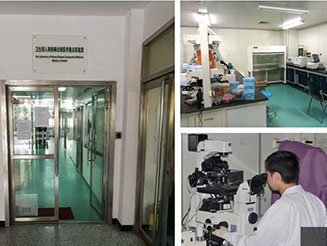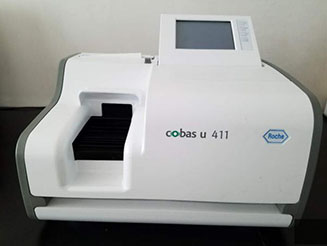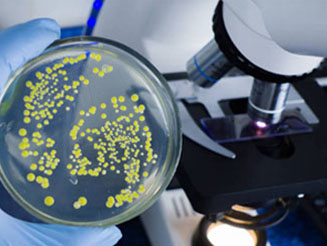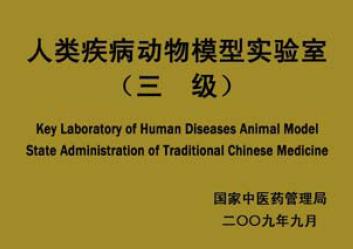- Research Center
- Technology Platform
- Main Lab
-

Differentiation Research Center for Modern Animal Models of Traditional Chinese Medicine
DetailsAs China's unique and valuable intellectual wealth, traditional chinese medicine is gradually recognized and valued worldwide. However, the better development of TCM requires the intervention of laboratory science to be interpreted by modern science, and animal model plays an important role as a bridge. The center provides modern scientific tools for the research and evaluation of Traditional Chinese Medicine (TCM) by studying the omics of genes and proteins, and the relationship between animal models of diseases and “differentiation”.
-

Translational Medicine Research Center
DetailsEstablished in September 2017, the translational medicine center focuses on major diseases that threaten human health. Based on and supported by laboratory animal sciences research, the center rapidly and effectively applies basic research results to the clinic, providing resources, data and programs for revealing the nature of diseases and clinical treatment.
-

Pathogen Laboratory Research Center
DetailsThe Institute has more than 30 years of experience in the study of infectious diseases since 1986 and emerging infectious diseases since 2003. In 2012, the Institute integrated the research group of infectious diseases and established the Pathogen Laboratory Research Center (hereinafter referred to as the Pathogen Center), which became one of the four research centers of the Institute. Relying on the united laboratory of emerging and remerging infectious diseases jointly established by animal model research of emerging and remerging infectious diseases of the Institute, Beijing municipal key laboratory of infectious diseases, and national key laboratory, emerging infectious diseases of the university of Hong Kong, pathogen center focuses on creating animal models of infectious diseases, the innovation research on infectious diseases, fully supportting comprehensive prevention and control of infectious diseases and scientific research of our country and the world.
-

Comparative Medical Research Center
DetailsAs one of the four research centers of the Institute of Laboratory Animal Sciences of the Chinese Academy of Medical Sciences, the Center covers the systematic comparative medical research of major human diseases.
-

Laboratory Animal Resources Research Center
DetailsThe center has been committed to the research of laboratory animal resources for a long time, and has a mature system of mouse gene editing technology, which can quickly and efficiently establish the gene knockout, conditional knockout, gene knockout and transgenic mouse gene engineering animal model, and carry out the phenotypic analysis and disease research of the animal model based on this. At the same time, the center also focuses on laboratory work on wild animals such as the Bush vole. After years of efforts, nearly 100 SCI papers have been published in recent five years, including journals such as Cell, Nature and Cell Research. CRISPR/ Cas9-based conditional knockout and gene knockout rats were established for the first time in the world, and China's first gene engineering rat resource bank was established.
-

Centre for Safety Evaluation and Research of Drugs
DetailsThe New Drug Safety Evaluation and Research Center (GLP Center) is dedicated to the preclinical safety evaluation and pharmacodynamic evaluation of drugs, as well as the preclinical evaluation of medical devices and health products. In 2007, it passed the GLP qualification certification of CFDA, the International AAALAC accreditation and the National Laboratory Accreditation (CNAS).
-

Infectious Disease Research Platform
DetailsInfectious diseases research platform is the unique multi-dimensional and comprehensive infectious disease animal model technology platform with multi-species, multi-diseasethat integrating non-human primates, rodents and other characteristic species in China.
-

Labortary Animal Behavior Analysis Platform
DetailsThe Animal Behavior Analysis Platform of Institute of Laboratory Animal Sciences, Chinese Academy of Medical Sciences was established in 2009. The rodent facility on platform covers 268 square meters, and the non-human primate facility covers 179 square meters. Among them, the rodents were equipped with a complete barrier air conditioning system, and the behavioral experiments were carried out in the barrier system, which ensured the objectivity of the experimental results of animal behavior to the greatest extent.
-

Comparative Medical Information Service Platform (Information Platform)
DetailsEstablished in September 2012, the Comparative Medical Information Platform of Institute of Laboratory Animal, Sciences of Chinese Academy of Medical Sciences, affiliated to the Information Center of the Institute, is a technology platform for big data analysis of laboratory animals and comparative medicine. There are 5 staff members, including 1 distinguished professor and 1 associate researcher.
-

Beijing Key Laboratory of Animal Models of Emerging and Reemerging Infectious Diseases
Details"Beijing Key Laboratory of Animal Models of Emerging and Reemerging Infectious Diseases" involves in China's major new infectious diseases, especially the integration of laboratory animals and agent resources. Through research and analysis of highly consolidated infectious disease model, a multi-species, multi-disease, multi-dimensional and comprehensive laboratory for animal model research of infectious diseases has been established integrating a set of non-human primates, rodents and other characteristics species. The main research direction is to integrate the resources of various animals and strains, establish a large-scale, standardized and systematic animal model research platform for emerging and re-emerging infectious diseases, in order to solve the bottleneck problem in the research of emerging and re-emerging infectious diseases, and provide evaluation criteria for the evaluation of anti-infective drugs and vaccines. Through the integration of animal models of pathological analysis and behavior analysis, and a series of key technologies of gene engineering technical services and laboratory animal image analysis, animal model repository has formed with scale, standardization and systematization of HIV/AIDS, tuberculosis, hepatitis, highly pathogenic flu, and severe emerging and reemerging infectious diseases with potential input risk, in order to improve the level of system analysis model and service ability, to realize the standardization of the animal model to evaluate technical indicators for infectious disease research, drug and vaccine evaluation model. It is built into the international level of biological safety laboratory base, technology and resource sharing base and biological safety personnel training base.
-

Level III Laboratory of Human Diseases Animal Model State Administration of Traditional Chinese Medicine
DetailsThe level III Laboratory of Human Diseases Animal Models under the State Administration of Traditional Chinese Medicine is mainly responsible for the research of traditional Chinese medicine in animal models, which includes three aspects. First, it provides genetic engineering model resources for traditional Chinese medicine research, and provides a technical platform for model analysis for traditional Chinese medicine research through the opening of the laboratory. The second is to cooperate with researchers of traditional Chinese medicine to analyze and sort out the dialectical information of genetic engineering animal models and establish the dialectical information base of genetic engineering animal models. Thirdly, the mechanism of TCM is studied by using the disease model.
-

Key Laboratory of Comparative Medicine for Human Diseases, National Health Commission
DetailsThe overall positioning of the Key Laboratory of Comparative Medicine for Human Diseases of the National Health Commission (hereinafter referred to as the Key Laboratory) is to establish the most comprehensive animal disease model base and resource sharing base for major infectious diseases, cardiovascular and cerebrovascular diseases, neurodegenerative diseases, tumors, metabolic diseases and senile diseases in China. Comparative medical research was conducted based on animal models of human diseases. The main research directions of the key laboratory include: 1) Study on animal models susceptible to infectious diseases and the interaction between pathogens and hosts; 2) Gene function description, the relationship between gene coding and development and aging; 3) Creation and research of animal models of cardiovascular and cerebrovascular diseases; 4) Model creation and comparative medical research on degenerative diseases; 5) Research on genome modification technology system and animal model resources of genetic engineering; 6) Resource maintenance and sharing and quality assurance system.

 WeChat
WeChat